All daffodils are delightful spring flowers. However, there’s something extra special about large-cupped daffodils with their big, glorious blooms. So let’s explore 14 types of large-cupped daffodils that add extraordinary presence to any garden. Plus, we’ll provide easy steps to naturalize them in your landscape.

Large-Cupped daffodils produce one flower per stem.
©sebastianosecondi/Shutterstock.com
What are Large-Cupped Daffodils?
Need a quick explanation or refresher about large-cupped daffodils? We’re here to help! These bold and beautiful daffodils are easy to identify by their two main defining characteristics.
First, large-cupped daffodils grow one large flower per stem. Second, as a rule of thumb, their cup size is greater than one-third but less than equal to the length of their petals.
This type of daffodil belongs in the second of 13 official daffodil divisions outlined by the Royal Horticultural Society. So if you need a quick list of those divisions, keep reading below!

One way to identify a large-cupped daffodil is by its sizable trumpet cup.
©Sergey V Kalyakin/Shutterstock.com
There Are 13 Daffodil Divisions for Identification
The 13 divisions of daffodils make identifying these spring flowering bulbs a lot easier. See the list of division titles below for quick reference.
- Daffodil Division #1: Trumpet
- Daffodil Division #2: Large-Cupped
- Daffodil Division #3: Small-Cupped
- Daffodil Division #4: Double
- Daffodil Division #5: Triandrus
- Daffodil Division #6: Cyclamineus
- Daffodil Division #7: Jonquilla
- Daffodil Division #8: Tazetta
- Daffodil Division #9: Poeticus
- Daffodil Division #10: Bulbocodium
- Daffodil Division #11a: Split-Cupped Collar
- Daffodil Division #11b: Split-Cupped Papillion
- Daffodil Division #12: Other Cultivars
- Daffodil Division #13: Distinguished Only by Their Botanical Name
Large-cupped daffodils belong in the second division and are quite similar to trumpet daffodils. To illustrate these features, let’s take a look at some incredible types of large-cupped daffodils for spring garden blooms!

‘Accent’ large-cupped daffodils have salmon-pink cups.
©sebastianosecondi/Shutterstock.com
1. Narcissus ‘Accent’
Botanical Name: Narcissus ‘Accent’
Common Names: Small-Cupped ‘Accent’ Daffodil, ‘Accent’ Daffodil
Hardiness Zones: 3-8
Bloom Seasons: Spring (Mid)
Type of Daffodil: Large-Cupped, Division #2
Fragrance: Sweetly scented
Color: Soft cream petals and salmon-pink cups with darker rims
With ruffled cups and slightly reflexed petals, ‘Accent’ daffodils are lovely and distinct. According to Holland Bulb Farms, ‘Accent’ plants are the first truly pink daffodils. Though only their cups are pink against pure white petals. In addition to their bicolor magnificence, ‘Accent’ daffodils are vigorous and bloom in mid-to-late spring.
‘Accent’ plants reach 1-2 feet tall and produce showy 4-inch blooms. They also received the American Daffodil Society’s prestigious Wister Award.

‘Carlton’ large-cupped daffodils are golden yellow with a honey-like scent.
©PQK/Shutterstock.com
2. Narcissus ‘Carlton’
Botanical Name: Narcissus ‘Carlton’
Common Names: Large-Cupped ‘Carlton’ Daffodil, ‘Carlton’ Daffodil
Hardiness Zones: 3-8
Bloom Seasons: Spring (Mid)
Type of Daffodil: Large-Cupped, Division #2
Fragrance: Strong and sweet vanilla fragrance
Color: Golden yellow petals and cups
The bright and cheery ‘Carlton’ daffodil is an all-yellow type of large-cupped daffodil with prominent trumpet cups. And this showy flower’s blooms are significant at 4-5 five inches wide! In addition, ‘Carlton’ plants grow 1-2 feet tall and bloom mid-spring.
‘Carlton’ is a vigorous yellow daffodil that comes back every year. And this golden beauty won the coveted Award of Garden Merit presented by the Royal Horticultural Society.
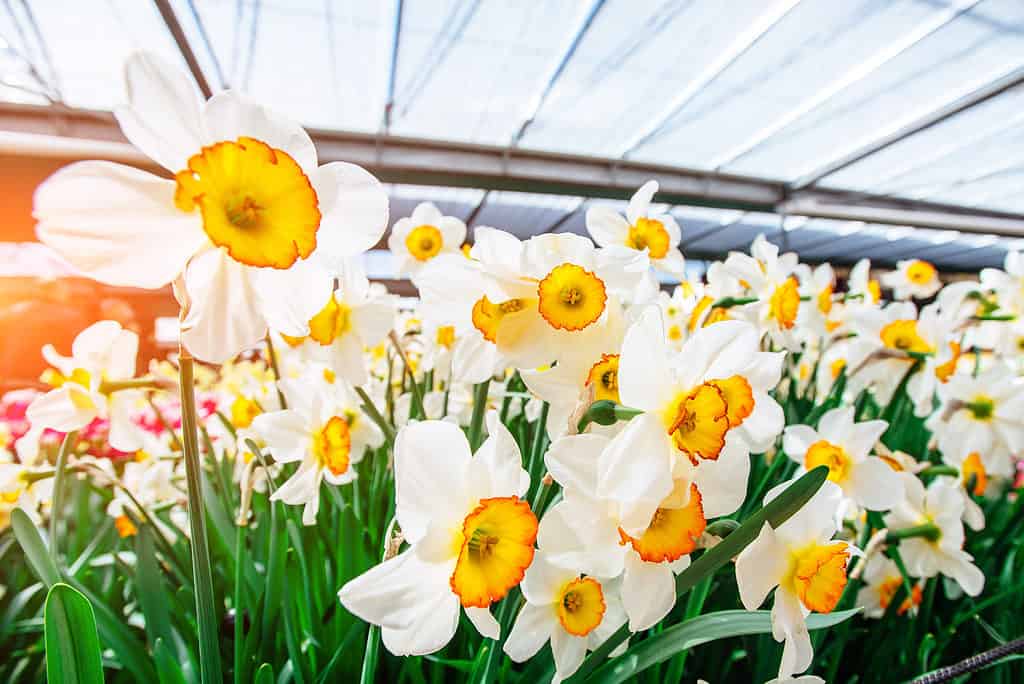
‘Flower Record’ Large-Cupped Daffodil
©Standret/Shutterstock.com
3. Narcissus ‘Flower Record’
Botanical Name: Narcissus ‘Flower Record’
Common Names: Large-Cupped ‘Flower Record’ Daffodil, ‘Flower Record’ Daffodil
Hardiness Zones: 3-8
Bloom Seasons: Spring (Mid, Late)
Type of Daffodil: Large-Cupped, Division #2
Fragrance: Lightly scented
Color: White petals with pale yellow cups
The ‘Flower Record’ daffodil is a beloved star of the large-cupped daffodils. Highly popular, this white perennial flower has a very classic look with its wide trumpet cups. Also, this daffodil’s pretty yellow cups have ruffled reddish-orange rims. In particular, the striking contrast between its white petals and golden cups is a big part of this flower’s charm.
‘Flower Record’ has a light scent, grows 1-2 feet tall, and blooms later in the spring. It’s also a type of large-cupped daffodil that’s easy to naturalize.

The ‘Fortissimo’ large-cupped daffodil has yellow petals and striking orange cups.
©Andreas Krumwiede/Shutterstock.com
4. Narcissus ‘Fortissimo’
Botanical Name: Narcissus ‘Fortissimo’
Common Names: Large-Cupped ‘Fortissimo’ Daffodil, ‘Fortissimo’ Daffodil
Hardiness Zones: 3-8
Bloom Seasons: Spring (Mid)
Type of Daffodil: Large-Cupped, Division #2
Fragrance: Sweet floral fragrance
Color: Yellow petals and dark orange cups
The ‘Fortissimo’ daffodil has an eye-catching bicolor look. Namely, its fragrant yellow petals and orange cups are unique and attract pollinators to the garden. In addition, this late-blooming type of large-cupped daffodil is a popular plant for flower gardens, naturalized areas, and wildflower meadows. You could also grow ‘Fortissimo’ in pots too.
‘Fortissimo’ is a vigorous daffodil that grows up to 1-2 feet tall and blooms in the middle of spring. Also, its incredible flowers grow up to 5 inches wide!

The ‘Fortune’ large-cupped daffodil provides 4-inch flowers in mid-spring.
©/Shutterstock.com
5. Narcissus ‘Fortune’
Botanical Name: Narcissus ‘Fortune’
Common Names: Large-Cupped ‘Fortune’ Daffodil, ‘Fortune’ Daffodil
Hardiness Zones: 3-8
Bloom Seasons: Spring (Mid)
Type of Daffodil: Large-Cupped, Division #2
Fragrance: Lovely, sweet scent
Color: Light yellow petals with pale orange cups
‘Fortune’ is an heirloom daffodil with light yellow petals and pale orange frilly cups. And its coloring is similar to the ‘Fortissimo’ daffodil (see above) but with more muted hues. In addition, ‘Fortune’ flowers grow up to 4 inches across and have a sweet scent.
This type of large-cupped daffodil produces flowers in mid-spring and grows 1-2 feet tall. Plus, ‘Fortune’ is another daffodil that naturalizes beautifully.
Did you know that daffodils are some of the easiest plants to naturalize? If you’re unfamiliar with the naturalizing process, keep reading to the end of this article for daffodil naturalizing tips!
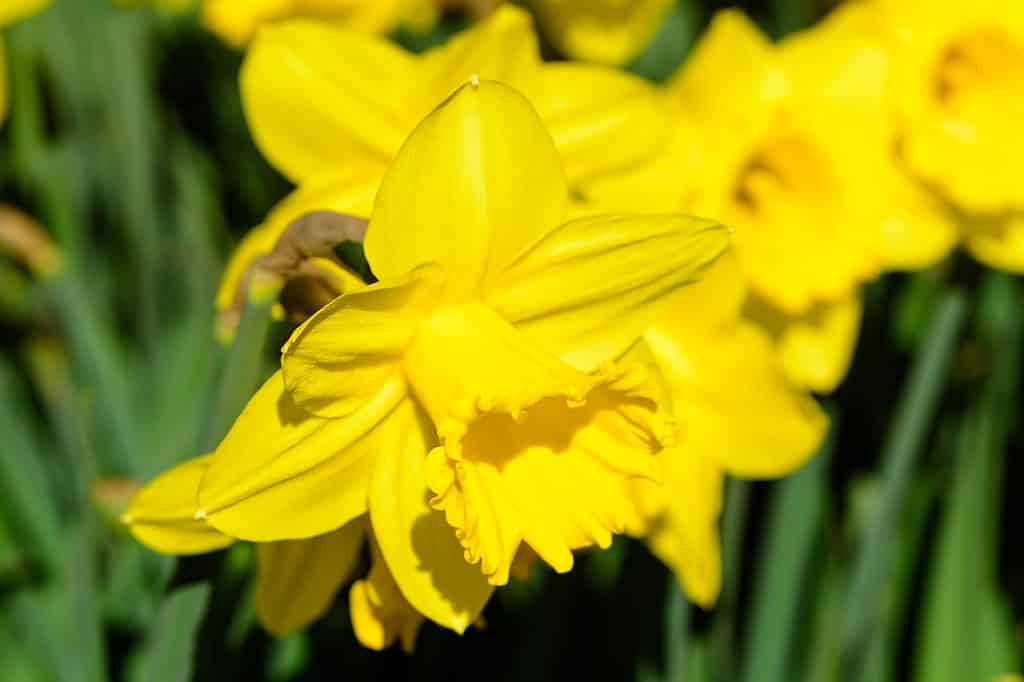
‘Gigantic Star’ is an all-yellow daffodil that smells like vanilla.
©Imfoto/Shutterstock.com
6. Narcissus ‘Gigantic Star’
Botanical Name: Narcissus ‘Gigantic Star’
Common Names: Large-Cupped ‘Gigantic Star’ Daffodil, ‘Gigantic Star’ Daffodil
Hardiness Zones: 3-8
Bloom Seasons: Spring (Early, Mid)
Type of Daffodil: Large-Cupped, Division #2
Fragrance: Pleasing vanilla fragrance
Color: Golden-yellow petals and cups
The ‘Gigantic Star’ daffodil is an old-fashioned favorite with large all-yellow flowers. Its huge blooms grow about 5 inches across and have prominent trumpets. In addition, ‘Gigantic Star’ has cups that look like stars or suns with their decorative edges.
‘Gigantic Star’ grows up to 1-2 feet tall, blooms mid-to-late spring, and is easy to grow. And its showy star-shaped cups add star quality to any garden.

‘Ice Follies’ is a type of large-cupped daffodil with a cup that changes color as it matures.
©Ausra Barysiene/Shutterstock.com
7. Narcissus ‘Ice Follies’
Botanical Name: Narcissus ‘Ice Follies’
Common Names: Large-Cupped ‘Ice Follies,’ ‘Ice Follies’ Daffodils
Hardiness Zones: 3-9
Bloom Seasons: Spring (Early, Mid)
Type of Daffodil: Large-Cupped, Division #2
Fragrance: Pleasing sweet scent
Color: White petals with pale yellow cups that mature to cream
‘Ice Follies’ large-cupped daffodils have creamy white petals and pale yellow inner cups that mature to white. In addition, its large cups have pretty ruffled edges, and the whole flower smells so sweet. Also, daffodil gardeners love this plant’s long-lasting blooms that appear early to mid-spring.
You can expect ‘Ice Follies’ plants to grow 12-24 inches tall and produce beautiful 4-inch blooms. And, just like other types of large-cupped daffodils, ‘Ice Follies’ usually provides one large flower per stem.
The ‘Ice Follies’ cultivar has won multiple awards, including the Amerian Daffodil Society’s Wister Award. In addition, this daffodil earned the Award of Garden Merit from the United Kingdom’s Royal Horticultural Society.
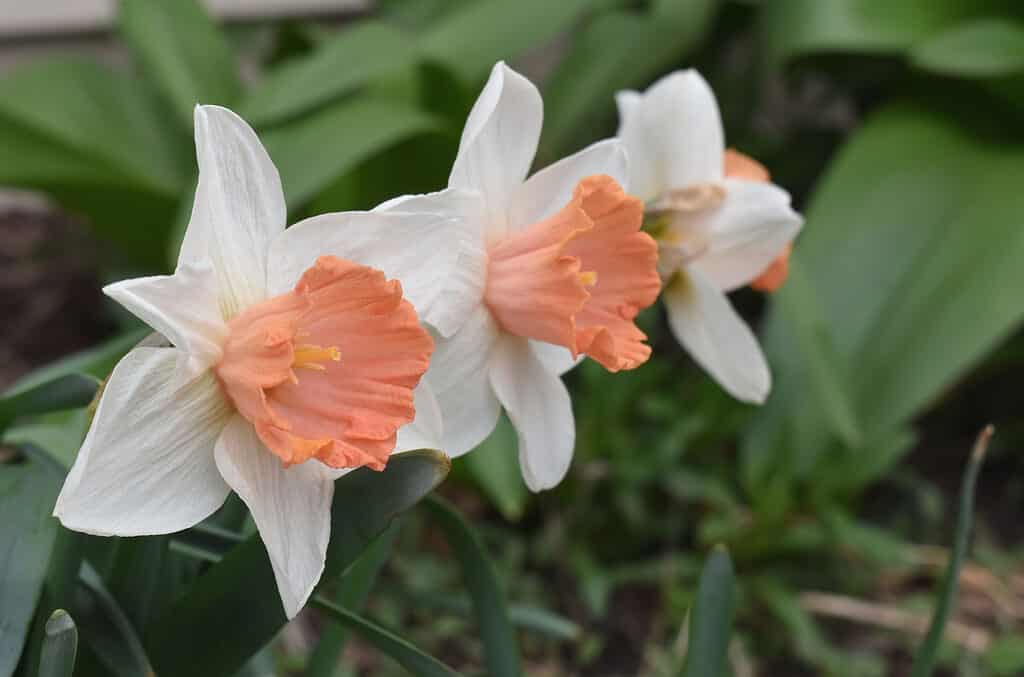
‘Passionale’ large-cupped daffodils smell sweet and bloom in mid-spring.
©iStock.com/gurineb
8. Narcissus ‘Passionale’
Botanical Name: Narcissus ‘Passionale’
Common Names: Large-Cupped ‘Passionale’ Daffodil,’ Passionale’ Daffodil
Hardiness Zones: 3-9
Bloom Seasons: Spring (Mid)
Type of Daffodil: Large-Cupped, Division #2
Fragrance: Delightfully sweet fragrance
Color: Ivory-white petals and a pink-orange cup
‘Passionale’ is a lovely white daffodil with frilly cups tinged with a pinkish-orange hue. Furthermore, this stunning large-cupped daffodil produces one 4-inch flower per long stem, making it an excellent choice for cutting gardens and vase arrangements.
Two-toned ‘Passionale’ grows 1-2 feet tall and offers its showy blooms in mid-spring. And this is another daffodil variety with a wonderfully sweet fragrance.
Additionally, ‘Passionale’ is an award-winning large-cupped daffodil that received the Royal Horticultural Society’s highly acclaimed Award of Garden Merit.
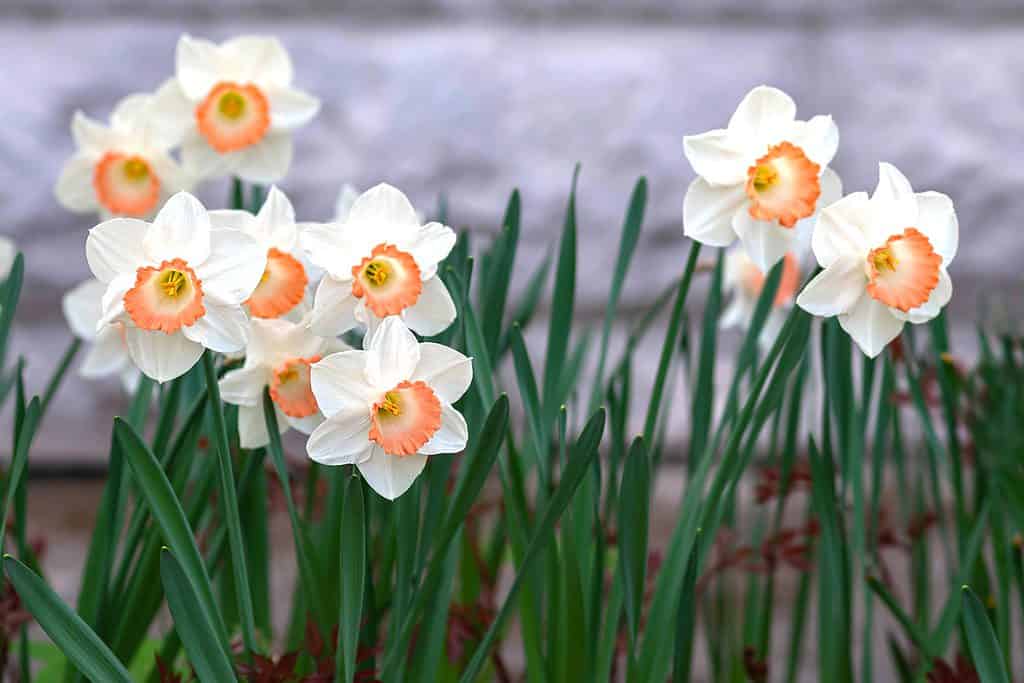
White ‘Pink Charm’ daffodils have cups with frilly coral-pink rims.
©berdimm/Shutterstock.com
9. Narcissus ‘Pink Charm’
Botanical Name: Narcissus ‘Pink Charm’
Common Names: Large-Cupped ‘Pink Charm’ Daffodil, ‘Pink Charm’ Daffodil
Hardiness Zones: 3-9
Bloom Seasons: Spring (Mid)
Type of Daffodil: Large-Cupped, Division 2
Fragrance: Mild sweet scent
Color: White petals with coral-pink rimmed cups
‘Pink Charm’ daffodils feature 4-inch flowers with elegant bicolor beauty. This type of large-cupped daffodil has classic white petals and cups with coral-pink rims. There’s also a hint of yellow at the bottom of their cups, giving ‘Pink Charm’ blooms some sunny glow too.
The ‘Pink Charm’ daffodil grows an average of 18 inches tall and delivers one 4-inch bloom per stem. Additionally, it has a lightly sweet scent.
Another plus? ‘Pink Charm’ won the John and Gertrude Wister Award from the American Daffodil Society. The Wister Award recognizes outstanding vigorous and showy daffodils with long-lasting blooms.

‘Pink Pride’ is a bicolor large-cupped daffodil.
©D J Reed/Shutterstock.com
10. Narcissus ‘Pink Pride’
Botanical Name: Narcissus ‘Pink Pride’
Common Names: Large-Cupped ‘Pink Pride’ Daffodil, ‘Pink Pride’ Daffodil
Hardiness Zones: 3-8
Bloom Seasons: Spring (Mid)
Type of Daffodil: Large-Cupped, Division #2
Fragrance: Strong sweet fragrance
Color: White petals with pink-apricot trumpets that mature to coral
The white-petaled ‘Pink Pride’ daffodil has cups that look pink or apricot, depending on the light. However, its pinkish cups mature to a striking coral shade. As a result, its color-changing feature and more make this type of large-cupped daffodil a fan favorite!
‘Pink Pride’ offers large 4-5 inch blooms in mid-spring. In addition, the plant grows 12-18 inches tall and naturalizes with ease.
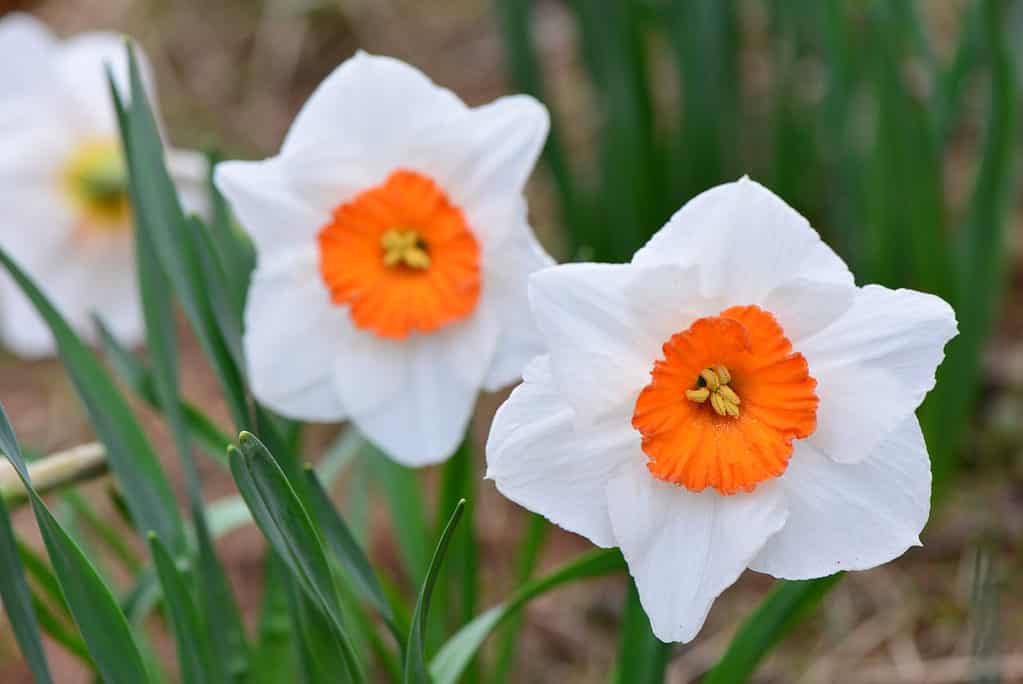
‘Professor Einstein’ daffodils have beautiful bicolor contrast with pure white petals and dark orange cups.
©Narit Jindajamorn/Shutterstock.com
11. Narcissus ‘Professor Einstein’
Botanical Name: Narcissus ‘Professor Einstein’
Common Names: Large-Cupped ‘Professor Einstein’ Daffodil, ‘Professor Einstein’ Daffodil
Hardiness Zones: 3-8
Bloom Seasons: Spring (Mid)
Type of Daffodil: Large-Cupped, Division 2
Fragrance: Sweet scent
Color: Pure white petals with dark reddish-orange cups
‘Professor Einstein’ daffodils are real showstoppers with dark reddish-orange cups at the center of pure white petals. This beautiful plant proves that bicolor blooms are especially stunning on large-cupped daffodils. In addition to its beautiful color contrast, ‘Professor Einstein’ produces large blooms up to 4 inches wide.
The ‘Professor Einstein’ daffodil grows 12-24 inches tall and has a pleasant sweet smell. In short, it’s a mid-spring bloomer and makes a magnificent cut flower.

Colorful ‘Roulette’ daffodils have white petals and yellow cups with orange outer rims.
©Sandyjim/Shutterstock.com
12. Narcissus ‘Roulette’
Botanical Name: Narcissus ‘Roulette’
Common Names: Large-Cupped ‘Roulette’ Daffodil, ‘Roulette’ Daffodil
Hardiness Zones: 3-8
Bloom Seasons: Spring (Mid, Late)
Type of Daffodil: Large-Cupped, Division 2
Fragrance: Mildly scented
Color: White petals and lemony cups with orange ridges
‘Roulette’ daffodils shine with elegant white petals framing lemon-yellow cups ridged with orange. In addition, these huge 5-6 inch blooms have ruffled trumpets that give them a starburst effect.
The ‘Roulette’ daffodil grows 12-18 inches tall and offers its stunning blooms later in the spring. And this showy large-cupped daffodil is another plant that easily naturalizes in lawns and meadows.

‘Salome’ large-cupped daffodils have cups that turn from pale yellow to salmon pink.
©Ian Grainger/Shutterstock.com
13. Narcissus ‘Salome’
Botanical Name: Narcissus ‘Salome’
Common Names: Large-Cupped ‘Salome’ Daffodil, ‘Salome’ Daffodil
Hardiness Zones: 3-8
Bloom Seasons: Spring (Mid)
Type of Daffodil: Large-Cupped, Division 2
Fragrance: Lovely floral scent
Color: Cream petals with pale yellow cups that mature to salmon-pink
Award-winning ‘Salome’ daffodils provide softly muted blooms of cream and yellow. Then its cups eventually fade to a lovely salmon color before the flowers wilt. Additionally, ‘Salome’ is a type of large-cupped daffodil that dazzles with large blooms about 4 inches wide.
This daffodil blooms in mid-spring and grows an average of 14 inches tall. And you can count on its award-winning vigorous growth habit, in addition to its soft colors.
‘Salome’ received the Award of Garden Merit presented by the Royal Horticultural Society. This large-cupped daffodil also earned the American Daffodil Society’s esteemed Wister Award.
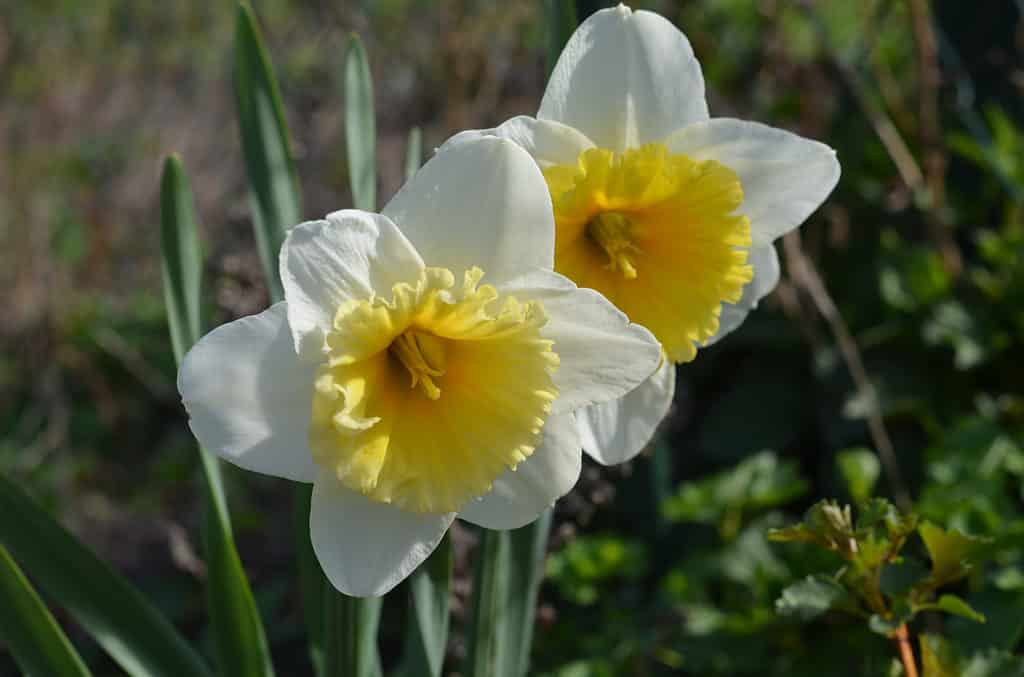
‘Slim Whitman’ white daffodils have large and frilly yellow cups.
©Aleksandr Naumenko/Shutterstock.com
14. Narcissus ‘Slim Whitman’
Botanical Name: Narcissus ‘Slim Whitman’
Common Names: Large-Cupped ‘Slim Whitman’ Daffodil, ‘Slim Whitman’ Daffodil
Hardiness Zones: 3-8
Bloom Seasons: Spring (Early, Mid)
Type of Daffodil: Large-Cupped, Division #2
Fragrance: Delightful sweet scent
Color: White petals and golden yellow cups
‘Slim Whitman’ daffodils have ivory petals beneath golden yellow-orange cups with ivory ruffled rims. Also, these large-cupped varieties offer up blooms that are 4 inches wide on plants that grow 12-18 inches tall.
The ‘Slim Whitman’ is a sport of the ‘Ice Follies’ daffodil. According to the American Daffodil Society, a sport is a genetic mutation of another plant. And, in this case, both the sport and the original are stunning types of large-cupped daffodils!
Though that wraps up our list of 14 types of large-cupped daffodils, keep reading to learn how to naturalize ‘Slim Whitman’ cultivars and more.
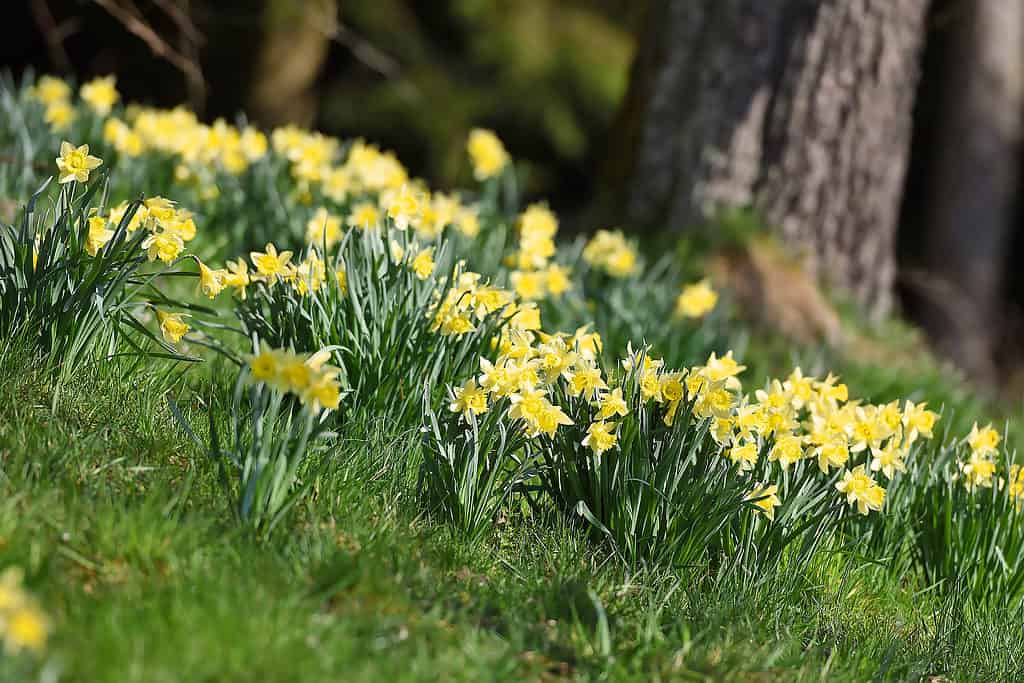
Most daffodils are easy to naturalize across lawns, meadows, and fields.
©Spitzi-Foto/Shutterstock.com
How to Naturalize Daffodils
No matter their division, daffodils are among the easiest plants to naturalize. Naturalizing means planting large groups of bulbs in sunny areas outside the boundaries of your garden. And a daffodil’s ability to naturalize so easily is one reason it is a popular garden plant — they require minimal care!
Lawns, slopes, meadows, and fields come to life with naturalized daffodils. And the steps for naturalizing daffodils are easy and bring many years of rewards.
Here are some easy tips for how to naturalize daffodils in your landscape:
- Plant daffodil bulbs at least 6 inches deep and 3-4 inches apart. In addition, scatter your bulbs in drifts or casual groupings as if they self-seeded. As a result, this planting method will help daffodils look naturally wild in your landscape.
- Choose an area with full sun or partial shade that has well-draining soil. Also, selecting a location that doesn’t need to be mowed until summertime is best.
- For best results, spread a layer of compost or bulb fertilizer before planting.
- Water them well right after planting the bulbs in autumn. Next, keep the soil moderately moist (not soggy) in spring until blooms emerge.
- For large-cupped varieties, give them plenty of room to grow.
- To encourage naturalizing, allow foliage to die back naturally in spring and summer.
- If you want even more daffodils to grow next year, divide and replant the bulbs in the fall.
Follow these easy tips, and you’ll have a naturalized landscape of beautiful daffodils!
All Types of Large-Cupped Daffodils are Extra Special!
We hope you agree that large-cupped daffodils provide special colors and shapes for spring garden interest. And among the 14 types of large-cupped daffodils featured here, it’s hard to choose just a few! Yet planting just one large-cupped variety could bring lots of bulb flower joy in the spring.
Whether growing in garden beds or naturalized in drifts, large-cupped daffodils in full bloom are special plants to enjoy.
The photo featured at the top of this post is © Ole Schoener/Shutterstock.com
Thank you for reading! Have some feedback for us? Contact the AZ Animals editorial team.







